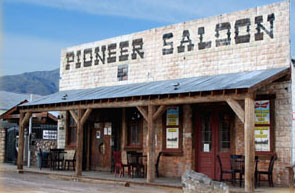
The Old West saloon conjures up images of gunfights, heavy drinking, dancing girls and brawling cowboys and gunfighters. It was also popular with miners and soldiers. The saloon was often depicted having duel wooden doors that swung open, a wide wooden boardwalk in front and a step higher than the dusty streets, a long hitching’ post in front.
Inside, a long oak or mahogany wooden bar, barstools and sets of tables and chairs completed the look along with a brass foot rail encircling the base of the bar and a row of spittoons spaced along the floor. The first of the western saloons, however, didn’t look anything like what we had seen in all those cowboy and western movies. Rather, they were tents or lean-tos that were quickly thrown together so that a traveler might stop to quench his thirst or strike up a conversation or a cowboy or miner might come to relax a spell during their off hours. Card playing, too, was a popular activity. As the town or settlement grew, the establishment took on the traditional features of the Old Western saloon that we’ve all come to expect.
Saloons of the American Wild West generally cropped up wherever pioneers established a settlement or where trails crossed. The first establishment to actually be called a “saloon” was the Brown’s Saloon at Brown’s Hole near the Wyoming-Colorado-Utah border. It was established in 1822 and catered heavily to the many fur trappers who traded during the old days. One of the Old West’s first saloons that catered to soldiers was at Bent’s Fort, Colorado in the late 1820s. The gold rush caused another increase in the construction and popularity of saloons. In 1848 when gold was discovered near Santa Barbara, California, the settlement only had a single cantina (Mexican for bar). Just a few years later, more than thirty saloons had cropped up.
Whiskey & Firewater Served
The whiskey served in many of the early saloons was strong stuff, a combination of raw alcohol, burnt sugar and chewing tobacco. Cactus Wine, made from a mix of tequila and peyote tea was popular as was something called a Mule Skinner made with whiskey and blackberry liquor. Rye or bourbon were also popular drinks and beer was served in high volume too, but it wasn’t served ice cold as it is today. If a barkeeper was ever going to water down his liquor, he did it with some really odd ingredients like turpentine, ammonia, gun powder or cayenne pepper. It packed a wallop either way. Firewater was a term originated when early traders were selling whiskey to Indians. They’d pour some of the whiskey on a fire to convince the Indians of the high alcohol content.
Card Playing & Deadly Gun Action
Faro was the most popular game played in western saloons, closely followed by poker and some dice games. Mixing alcohol and gambling could result in some deadly gun play. Professional gamblers quickly learned to protect their assets by honing their six-shooter skills at the same time as their gambling abilities.
The Expansion of the the Saloon
As saloons increased in popularity and townships prospered the saloon itself changed into many different forms, moving from the early plain drinking saloons to gambling saloons, hotel saloons, restaurant saloons and dance hall saloons. In the more populated settlements, these saloons catered to patrons 24 hours a day, every day of the week. Generally all were welcome with the exception of Chinese workers, soldiers who were blamed for infecting parlor house girls with diseases and respectable women. Unless they were saloon girls or shady ladies as some women gamblers were considered, ladies did not enter saloons. This tradition lasted until World War I. The ladies got their revenge when they initiated the temperance (prohibition) movement.
From Drink & Gambling to Public Meetings
Because the saloon was usually one of the first and bigger buildings within many new settlements, it became common to use it as a public meeting place before the real town halls entered the scene. For example, Judge Roy Bean had a combination saloon and courtroom from which he ran his business and ordered hangings. Downieville, California had a popular saloon which also served as the office of the local Justice of the Peace.
Famous Barkeeps & Violence
Some noted gunmen and lawmen of the wild west owned saloons too: Wild Bill Hickok, Bill Tighman, Wyatt Earp, Bat Masterson, Ben Thompson, Doc Holliday, to name a few, tended bar or dealt cards. Wild Bill Hickok, you’ll remember, ended up being killed by Jack McCall while playing poker in the No. 10 Saloon in Deadwood, South Dakota. Saloons were great brawling places too and fights would end up careening onto the streets.
If you happen to visit Tombstone, Arizona today you’ll get to see some authentic western saloons, replete with authentic furnishings and get a good feel of what life was like in the rugged old west.





